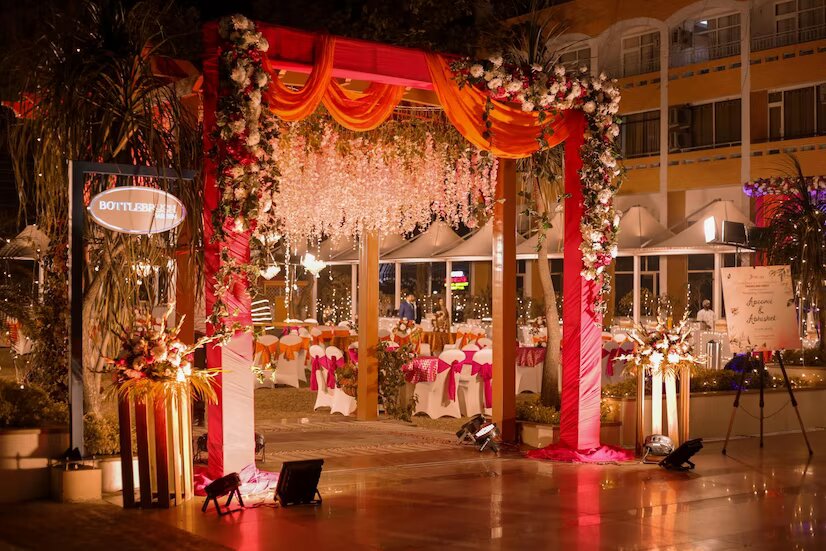Did you know that navy and blush make the best summer wedding colors? Orange and white are also the perfect match for the warm sunny weather.
Of course, if you don’t like any of these wedding colors, there are others to choose from. The same goes for almost every other season. There are a million shades at your disposal, you need to decide your favorite one.
The problem is picking ones that won’t clash with your venue or floral arrangement. If that’s not enough of a challenge, you’ll need to choose at least five shades.
Check out this wedding planning guide for a few tips and tricks to take to heart.
1. Walk Around Your Venue
It’s important to study your venue before getting your heart set on a color palette.
Walk around and take note of the wallpaper, the carpet, and the decor. From there, write down a list of colors you think would complement the room.
In case of an outdoor venue, try visiting it at the same time of year when you have your wedding date. You will get an idea of the flowers that bloom and what the tree leaves look like.
2. Consider The Season
What season are you planning on getting married? Fall is full of warm oranges and reds. You can match that energy with colors such as orange, beige, navy, mauve, grey, and emerald.
If you’re going for a winter wedding, black looks gorgeous in front of a snowy landscape. Red and forest green are also stunning choices.
Spring is all about the pastels. Light pink, blue, and purple are perfect choices.
Sage green bridesmaid dresses and floral arrangements pair well with summer weddings. You can also lean into the sunny weather by choosing an orange-and-white color palette.
3. Choose Your Floral Arrangement
If you’re drawing a blank on colors, move on to the next step of planning your wedding by picking out your floral arrangement. What kind of flowers do you want to make an appearance?
Do these flowers come in the wedding colors that you’re considering? If not, will they at least match?
Make sure your choice of flower complements the color options you are choosing. There’s no point in mismatching things on a day as important as your wedding day.
4. Pick Colors You Like
You don’t have to follow popular wedding themes if you and your future spouse aren’t feeling it. Just because orange is a trend for fall weddings doesn’t mean you should force yourself to choose it if you hate the color.
Pick something that you both like. If you want to go the simple route of using your favorite colors, by all means, do so. If you are still running out of ideas, try looking at your closet.
Check what colors are mostly available in your wardrobe. These colors make you confident, and as a result, you should consider choosing them on your big day.
5. Choose About Five Colors
The hard part about choosing your wedding colors is that you need more than one or two. Ideally, you should pick at least five.
Your main colors will be the ones you use for the bridesmaid dresses and large flowers. You’ll incorporate secondary colors into your napkin arrangement and invites.
Highlight shades are the little pops of color in a floral arrangement or envelope liners. Nowadays, there are entries of new color hues such as metallics and neutrals. You might also want to incorporate them into your wedding theme.
Color Theory To Implement When Selecting Your Wedding Colours
Exactly like the color of your room, the wedding color is also responsible for setting the mood. The choices of your color will make it easier for you to decide on other factors as well. Things such as linens, flowers, stationery, and bridesmaids’ outfits are determinants of your wedding color palette.
Well, you guessed it right. Choosing a color for your wedding is an indispensable decision to make. Among the various theories for choosing the right wedding color, color therapy is a renowned one.
Consider color therapy as the art classes you attended in school. It was a concept one had to understand properly. There are endless elements that work in the process. However, there are three pieces of the puzzle that will help you better comprehend the color wheel.
-
Primary Colours
There are hues that you cannot create by just combining two contrasting colors together. Thus, the three colors form the base for other colors on the palette red, blue, and yellow.
-
Secondary Colours
Secondary colors are the ones created using two primary colors. As mentioned already, orange is one of those colors. Purple, formed by the combination of blue and red, and green, formed by the mixture of blue and yellow, are the other two secondary colors.
-
Tertiary Colours
Tertiary colors are created by combining a secondary color, such as purple, along with a primary color, such as red. It becomes a new color altogether. These colors truly make the color wheel complete and also offer end number of options.
Color harmony is another thing to keep in mind when considering color theory. It helps in defining which colors look good when paired together. Have you ever wondered why green and pink are a perfect combination?
It’s due to the reason that they are complementary colors, indicating that they “sit” opposite to each other on the color palette. As a result, they are also called analogous colors.
Pick Out The Perfect Wedding Colors
There’s a lot that goes into choosing the perfect wedding colors. You have to consider both the season and your venue.
You also can’t only choose one or two colors and call it a day. You need at least five. We hope that you’re able to use the wedding ideas you’ve read here today to pick the perfect shades.
For more tips and tricks for planning your wedding, visit the Lifestyle section of our blog.
Additionals:




























